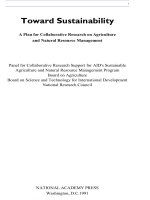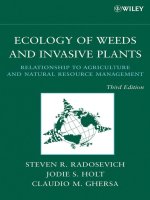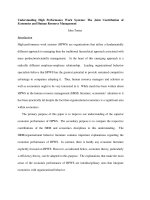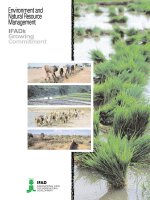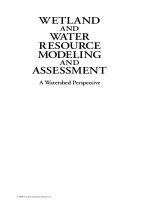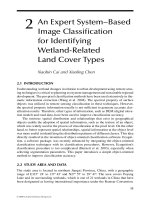Project vinh phuc flood risk and water resource management
Bạn đang xem bản rút gọn của tài liệu. Xem và tải ngay bản đầy đủ của tài liệu tại đây (3.57 MB, 46 trang )
Project: Vinh Phuc Flood risk and Water resource Management
TABLE OF CONTENTS
CHAPTER 1. OVERVIEW.................................................................................................................3
1.1 INTRODUCTION
1.2 BASIS FOR RDS PREPARATION
1.3 . PROJECT INTRODUCTION
1.4 PROCESS OF REPAIRING, UPGRADING
3
3
5
7
CHAPTER 2. NATURAL, PEOPLE’S LIVING, ECONOMIC CONDITIONS OF THE
PROJECT AREA.................................................................................................................................8
2.1 GEOGRAPHICAL LOCATION
2.2 TOPOGRAPHICAL, GEOMORPHOLOGIC CHARACTERISTICS
2.3 GEOLOGICAL CHARACTERISTICS
2.4 METEOROLOGICAL, HYDROLOGICAL CONDITIONS
2.5 SOCIO-ECONOMIC CURRENT SITUATION
8
8
9
11
13
CHAPTER 3. ASSESSING STATUS OF CLUSTER WORK.........................................................15
3.1 EARTH DAM
15
3.1.1Main dame............................................................................................................................................15
a.Dam-crest..................................................................................................................................................15
a.Upstream dam slope..................................................................................................................................16
b.Downstream dam slope..............................................................................................................................16
3.1.2Auxiliary dam 1....................................................................................................................................20
a.Dam crest...................................................................................................................................................20
b.Upstream dam slope..................................................................................................................................21
c.Downstream dam slope..............................................................................................................................21
3.1.3Auxiliary dam 2....................................................................................................................................22
c.Upstream slope..........................................................................................................................................23
d.Downstream dam slope..............................................................................................................................23
3.2 SPILLWAY
24
3.3 INCIDENT SPILLWAY
26
3.4 INTAKE CULVERT
27
3.5 MANAEGEMENT ROAD
29
3.6 MANAGEMENT HOUSE.
30
3.7 MONITORING EQUIPMENTS
30
3.8 RESERVOIR MANAGEMENT & OPERATION WORK
31
3.9 PLANS FOR FLOOD AND STORM PREVENTION AND DAM RESCUE
31
CHAPTER 4. ASSESSMENT OF THE DAM SAFETY.................................................................33
4.1 HYDROLOGICAL CALCULATION AND FLOOD REGULATION
33
4.2 CALCULATION OF DAM REST ELEVATION
33
4.2.1Calculation sequence............................................................................................................................33
4.2.2Calculation results................................................................................................................................36
4.3 CALCULATION OF CHECKING SEEPAGE
37
4.3.1Calculation purpose.............................................................................................................................37
4.3.2Applied calculation method and programme.......................................................................................37
Report on Dam Safety for Thanh Lanh reservoir – Vinh Phuc province
1
Project: Vinh Phuc Flood risk and Water resource Management
4.3.3Calculation documents.........................................................................................................................37
4.3.4Calculation results................................................................................................................................40
4.4 CALCULATION OF DAM STABILITY CHECK
40
4.4.1Calculation method and programme....................................................................................................40
4.4.2Calculation documents.........................................................................................................................40
4.4.3Calculation result of stability...............................................................................................................41
4.5 OPERATION AND MAINTENANCE PLAN FOR THE WORK
42
6.1 CONCLUSION
43
6.2 RECOMMENDATION
44
Report on Dam Safety for Thanh Lanh reservoir – Vinh Phuc province
2
Project: Vinh Phuc Flood risk and Water resource Management
CHAPTER 1. OVERVIEW
1.1 INTRODUCTION
1.1.1 Name of project, package
-
Project: Vinh Phuc Flood Risk and Water Resource Management Project (VPFRWMP)
-
Package: Consultancy on Preparation of Report on Dam Safety (RDS) for Thanh
Lanh reservoir.
1.1.2 The Owner
-
The Owner: Vinh Phuc ODA Management Board
1.1.3
Organizations, individuals preparing Report on Dam Safety
- Organizations in charge of RDS preparation: Development Research and Consultancy
Centre (DRCC)
-
Officers involved in RDS preparation
Project Manager:
Assoc. Pr. – Ph.D. Nguyen Canh Thai
Hydraulic Experts:
Msc. Dương Van Vien
Msc. Le Hong Phuong
Eng. Truong Ba Thin
Eng. Trinh Duy Thanh
Msc. Tran Duy Quan
Technical Experts:
Assoc. Pr. – Ph.D. Hoang Thanh Tung
Dr. Ngo Le An
Dr. Tran Kim Chau
1.1.4
-
Location of Project area
Location: Trung My commune, Binh Xuyen District, Vinh Phuc province
1.2 BASIS FOR RDS PREPARATION
1.2.1 Legal basis
-
Construction Law No. 50/2014/QH13 dated 18th June, 2014.
- Decree No. 143/2003/ND-CP dated 28th November, 2003 regulating in detail the
implementation of a number of articles of the Ordinance on exploitation and protection
of hydraulic works.
- Decree No. 67/2012 / ND-CP dated 10 September, 2012 on amending and
supplementing some articles of Decree No. 143/2003/ND-CP dated 28 November, 2003
of the Government on detailing the implementation of the some articles of the Ordinance
on exploitation and protection of irrigation works
Report on Dam Safety for Thanh Lanh reservoir – Vinh Phuc province
3
Project: Vinh Phuc Flood risk and Water resource Management
- Decree No. 112/2008/ND-CP dated 20th October, 2008 on the general management and
exploitation of natural resources and environment of hydroelectric, hydraulic reservoirs.
-
Decree No. 72/ND-CP dated 07th February 2007 on the dam safety management.
- Directions of the Government in Document No. 21/CT-TTg dated 14th October 2013 on
strengthening the reservoir safety management and assurance.
-
Circular No. 33/2008/TT-BNN dated 04th February 2008 on guiding a number of articles
of Decree No. 72/ND-CP.
- Operational policy on dam safety OP/BP 4.37 of the World Bank.
1.2.2
-
Other relevant current technical regulations, standards.
Regulations, standards applied to Report on dam sfaety preparation
National Technical Regulation QCVN 04-01:2010/BNNPTNT on the composition and
contents of preparing investment report, investment project, and economic and
technical report of hydraulic works.
-
National Technical Regulations QCVN 04-05: 2012 /BNNPTNT – Main provisions on
designing for irrigation works.
-
National standard TCVN 8216: 2009 – Design of compacted earth dam;
-
National standard TCVN 8421: 2010: Hydraulic works – Waves and ships-induced
load and force on the works;
1.2.3
Current regulations, standards.
Materials and softwares used in the report
a. Used documents:
To conduct the Dam safety report, the consultants made a number of main contents and
volume as follows:
- Collection of design documents of Thanh Lanh reservoir relating to RDS
preparation:
+ Documents of investment project of Thanh Lanh reservoir prepared in 1999 by
Hydraulic construction consulting company No.1.
- Survey, gathering of documents and studied about the livelihood, socioeconomy in the project area:
+ The population and society: Surveying and assessing the status of population
and society in the project area.
+ The situation of economic development, the development direction.
+ The situation of flood, flooding and drought in the project area.
Report on Dam Safety for Thanh Lanh reservoir – Vinh Phuc province
4
Project: Vinh Phuc Flood risk and Water resource Management
-
Documents of natural conditions of the project area:
+ Documents of meteorology: rain, wind, temperature, sunlight, air humidity ...
+ Documents of hydrology: inflow, flooding flows
-
Documents of topography, geology:
+ Documents of terrain, geology, surveying work at technical design phase,
prepared in 1999 by Hydraulic construction consulting company No.1.
b. Used softwares:
- GeoStudio 2007 (Canada) : seepage calculation, stability of earth dam.
- DTL2002 (Water resource University): calculate the flood regulation
- Other related solfwares.
1.3 . PROJECT INTRODUCTION
1.3.1 Project objectives
The objective of the project is to enhance the flood and inundation prevention
capability, mitigate the impact of disasters on the living of residents in the project area, and
enhance the efficiency of agriculture and non-agriculture production, contributing to poverty
reduction at the local. Besides, the project contributes to controlling flood risk, reducing and
regulating flood for the basin of Phan river, Ca Lo river; improving the capacity of flood
drainage, water storage and regulating for Phan River, Ca Lo river; establishing
infrastructures for the development of industrial parks and attracting investment; improving
ecological environment and forming regulating reservoirs, matching the general plan for
construction of Vinh Phuc urban, Vinh Phuc province to 2030, with a vision to 2050.
1.3.2 Objective of the dam safety consultancy services
Objective of the consultancy services is to assess Thanh Lanh reservoir dam safety and
auxiliary works to ensure that the investor could apply the necessary measures to ensure
dam safety. This objective will be achieved by visual inspection for the dam and auxiliary
works, and assessing the safety conditions of the reservoir and dam, including process of
management, operation and maintenance at the present. The assessment shall comply with
the procedures and regulations of Vietnam and the standards of the World Bank.
1.3.3 Overview of the work
Report on Dam Safety for Thanh Lanh reservoir – Vinh Phuc province
5
Project: Vinh Phuc Flood risk and Water resource Management
Thanh Lanh reservoir was built in Trung My commune, Binh Xuyen district,
Vinh Phuc province. The Reservoir was started the construction in 2001 and put into
use in 2006. Headworks cluster includes 1 main dam, 1 intake culvert placed left
abutment of the main dam, 2 auxiliary dams and 1 spillway located in the middle of
the Auxiliary Dam No. 2 line.
Thanh Lanh reservoir which is the work of grade II (Under QCVN 0405:2012/BNNPTNT) was built with the tasks to irrigate agricultural land of 1200ha of
four Communes of Trung My, Thien Ke, Ba Hien and Son Loi. In addition, it has also
used to prevent flooding for communes in the lowland area of Binh Xuyen district,
supplying the living water for residents in the beneficial area in the dry season…
Current parameters of the works:
No.
Parameter
I Reservoir
Whole area of basin
Total storage
Effective storage
Dead storage
NWL
Hi-rising WL
II
1.
Dead level
Earth Dam
Value
Km2
106m3
106m3
106m3
m
m
m
23.0
10,621
9,892
0.729
+76.60
+77.50
+62.20
Main dam
Structure
Elevation of dam crest
Elevation of parapet wall crest
Width of dam crest
Length of dam crest
Max height of dam
Upstream slope coefficient
Elevation of upstream berm
Width of upstream berm
Downstream slope coefficient
Elevation of downstream berm
Width of downstream berm
2.
Unit
Homogeneous earth dam
m
m
m
m
m
+78.10
+79.10
5.0
362.0
29.0
2.75 - 4.5
+68.10
3.5
2.75 – 3.0
+60.10
3.5
m
m
m
m
Auxiliary dam 1
Structure
Elevation of dam crest
Width of dam crest
Length of dam crest
Max dam height Hmax
Upstream slope coefficient
Homogeneous earth dam
m
m
m
m
Report on Dam Safety for Thanh Lanh reservoir – Vinh Phuc province
+79.10
5.0
76.0
12.0
3.0
6
Project: Vinh Phuc Flood risk and Water resource Management
No.
Parameter
Unit
Value
2.75
Downstream slope coefficient
3.
III
IV
Auxiliary dam 2
Structure
Elevation of dam crest
Width of dam crest
Length of dam crest
Max dam height Hmax
Upstream slope coefficient
Downstream slope coefficient
Intake culvert
Type of culvert
Elevation of intake-culvert sill
Dimension
Length of culvert
Slope of culvert bottom ic
Flow regime
Spillway
Form of spillway
Width of water spill
Number of valve gates
Form of valve-gate
Elevation of spillway sill
Continuous form
Form of dissipation
Homogeneous earth dam
m
m
m
m
+79.10
5.0
159.0
9.1
3.0
2.75
RC box culvert
m
m
m
+60.0
100
112.0
0.01
Unpressurized
Spill of pragmatic ophixerop with
valve gate
10.0
1
m
unit
Arch-shaped valve-gate
m
+71.6
Chute
Dissipation tank
1.4 PROCESS OF REPAIRING, UPGRADING
Thanh Lanh resevoir was built and put into use in 2007, the work has been in
operation for 8 years, the process of repairing, upgrading is as follows:
- In 2009, spouting-drilling to handle the waterproofing for auxiliary dam No. 2
- In 2013, constructing the rivetment to protect the management road from the
main Dam to Spillway.
- In March 2015, repairing the opening and closing machine of the downstream
cone valve of the intake culvert; replacing high-pressure pump and oil-feeding
hydraulic pipe system. Repairing the management house, replacing all windows and
doors, making the metal-sheet roofing for purposes of heat-resistance and leakage.
Report on Dam Safety for Thanh Lanh reservoir – Vinh Phuc province
7
Project: Vinh Phuc Flood risk and Water resource Management
CHAPTER 2. NATURAL, PEOPLE’S LIVING, ECONOMIC CONDITIONS OF
THE PROJECT AREA
2.1 GEOGRAPHICAL LOCATION
Thanh Lanh reservoir has the location of Work construction in Trung My
commune, Binh Xuyen district, Vinh Phuc province, and is far from the center of Vinh
Yen city of 12km in the direction of Northwest
- The North: is bordered by Tam Dao mountain range, and Thai Nguyen
province.
- The East : is bordered by Ngoc Thanh commune, Phuc Yen town.
- The West: is bordered by Minh Quang commune, Tam Dao district.
- The South: is bordered by Ngoc Thanh commune, Phuc Yen town.
Project area
Figure 2.1. Location of Work.
2.2 TOPOGRAPHICAL, GEOMORPHOLOGIC CHARACTERISTICS
In the North of Vinh Phuc is Tam Dao mountain range stretching from Dao Tru
commune (Tam Dao) - the northernmost point of the province to Ngoc Thanh
commune (Phuc Yen) - the easternmost point of the province with a length of 30 km,
Report on Dam Safety for Thanh Lanh reservoir – Vinh Phuc province
8
Project: Vinh Phuc Flood risk and Water resource Management
the Southwest is surrounded by the Red River and Lo River forming topographical
type gradually lowering from the Northeast to the Southwest and dividing the province
into three areas with specialized topography: plains, hills, low and medium mountains.
- Plain topography: includes 76 communes, wards and towns, with a natural area
of 46,800ha. The plain areas consists of old and new alluvial areas. The old alluvial
area is mainly formed by alluvial of large river systems such as the Red River, Lo
River, Day River, the area of this region is relatively wide, including the North of Me
Linh1, Yen Lac and Vinh Tuong districts and the South of Tam Duong, Binh Xuyen
districts, which were formed in the same period of the Red River delta formation
(Quaternary – Pleistocene Era). The new alluvial area along the rivers in the districts
of Song Lo, Lap Thach, Vinh Tuong, Yen Lac, Me Linh, the south of Binh Xuyen,
which were formed in the Quaternary period – Holocene Era. The land in plain area is
enriched by alluvial of the Red River, so it is very fertile, and the ideal condition to
develop intensive agriculture economy.
- Hill topography: includes 33 communes, wards and towns, with an natural area
of 24,900ha. This is favorable area for the development of industrial crops, fruit trees
and crops, combining with raising cattle, creating favorable conditions for the
restructuring of crops and raising by increasing the production of food goods.
- Lower and middle mountain topography: has a natural area of 56,300ha,
accounting for 46.3% of the natural area of the province. The topography of
mountainous areas is complex and separated, with many rivers and streams. This is
one of the advantages of Vinh Phuc province compared to the provinces around Hanoi,
because there are many favorable conditions for the development of concentrated
industrial parks and eco-tourism areas. Tam Dao mountain region covers an area of
15,753ha of national forest.
2.3 GEOLOGICAL CHARACTERISTICS
According to the survey conducted by Hydraulic Consulting Company No.1 (Hec1) in
1999, the geological conditions of the ground are as follows:
2.3.1 Geological conditions of main dam
- Layer (1a) is medium - heavy semi-clay, some locations are light semi-clay in
brown-yellow and gray-brown color, and in hard and flexible state with tight and
Report on Dam Safety for Thanh Lanh reservoir – Vinh Phuc province
9
Project: Vinh Phuc Flood risk and Water resource Management
moderate structure. The layer is mainly distributed in the mudflats of the stream bed,
the layer’s thickness is from 0.5÷ 1.0m.
- Layer (1) is sand and gravel of the stream bed in gray-white, gray-yellow color.
The gravel content makes up from 50÷ 60%, the rest is gravel, sand and less clay
particles. The layer is distributed on the surface of the stream bed.
- Layer (2) is semi-clay containing macadam and pebble in brown-red, browyellow color with the macadam content accounting for 20÷ 45%. The earth is in half
hard-hard state and tight-medium structure, and distributed mainly in the foothill of the
right abutment into 1 small stretch. The layer’s thickness is from 1÷ 8m and the layer
is derived from eluvial and alluvial (daQ).
- Layer (3) is heavy- medium semi-clay containing macadam and laterite in
brown-yellow, brown-red color. The macadam content accounts for 10-30% of
macadam and hard and solid laterite. The layer is in hard-half hard state and tightmedium structure and widely distributed on the surface of the hillside.
Original rock: of the foundation area is located in middle Triassic sediment of
grade Ladini of Deo Nhe layer and magma formations of Tam Dao.
2.3.2 Geological conditions of flood discharge spillway and auxiliary dam 2
- Layer (3) is heavy-medium semi-clay mixing a great deal of macadam and
laterite.It is in gray-brown, gray-yellow color. The mechanical and physical properties
of this earth are described such as the main dam foundation, the layer is widely
distributed on the surface of the spillway line with the thickness from 1 ÷ 3m.
- Layer (3a) is heavy-medium semi-clay containing macadam in brown-yellow,
brown-red color, the macadam content is from 2 ÷ 25%, macadam is soft. It is in hardhalf hard state and tight-moderate structure, the layer is distributed in the lenticular
form and under layer (3) with the thickness from 1 ÷ 2m.
- Original rock under the pillway foundation is silty clay stone, sandstone in
gray-green, light gray color, stone structure.
2.3.3 Auxiliary dam 1
- Layer (3) is medium semi-clay mixing many macadam and laterite in graybrown, gray-yellow color, the mechanical and physical properties of the layer are the
same as layer (3) as mentioned the main dam.
Report on Dam Safety for Thanh Lanh reservoir – Vinh Phuc province
10
Project: Vinh Phuc Flood risk and Water resource Management
- Original rock: Sericite quartz schist, stone was completely weathered into earth
and macadam.
2.3.4 Geological conditions of water intake culvert
The culvert is arranged in the left abutment of main dam, so the geology is from
the top down the same as main dam.
2.4 METEOROLOGICAL, HYDROLOGICAL CONDITIONS
2.4.1
Climate characteristics
Near the study basin, Vinh Yen meteorological station managed by the
Department of Meteorology and Hydrology has a long-time measurement with assured
quality of measurement and is about 8km Southwest of reservoir. Thus, the report is
proposed to use data of Vinh Yen meteorological station to calculate the study basin.
c. Average wind speed
Average wind speed in the project area is summed up from the data measured in
the reality of Vinh Yen meteorological station. The results are presented in the
following table:
Table 1-3: Average wind speed in the project location
Station
I
II
III
IV
V
VI
VII VIII IX
X
XI
XII
All
year
Vinh Yen (m/s) 1.6 1.9 2.0 2.3 2.2 1.9 1.9 1.5 1.3 1.3 1.3 1.4 1.7
d. Maximum indirection wind speed
Maximum indirection wind speed in the study area is calculated according to
data of Vinh Yen station. The results of calculating maximum wind speed
corresponding to design frequencies are shown in table 1-6. The details of calculation
and frequency lines are mentioned in the table.
Table 1-4: Maximum indirection wind speed corresponding to design frequencies
(m/s)
Wind direction
Average value
Cv
Cs
Non-direction
18.64
0.25
0.05
1
29.7
Frequency (%)
2
5
25
28.3 26.4 21.8
Report on Dam Safety for Thanh Lanh reservoir – Vinh Phuc province
50
18.6
11
Project: Vinh Phuc Flood risk and Water resource Management
e. Precipitation causing flood
Because Thanh Lanh reservoir has no precipitation measuring data, so the report
used precipitation data of Vinh Yen station to calculate the characteristics of
precipitation causing flood. The calculation results are as follows:
Table 1-5: Maximum daily precipitation in Vinh Yen station (mm)
X1maxaverage
128.9
Cv
0.51
Cs
1.80
X0.01%
655.4
X0.1%
504.5
X0.2%
460.0
X0.5%
401.7
X1%
358.1
X1.5%
332.7
2.4.2 Hydrological characteristics
f. Design flood flow
Because Thanh Lanh has no flow measuring data while the area of reservoir’s
basin is 22.3 km2, so according to Standard C6-77, the report of design flood
calculation of Thanh Lam reservoir is conducted by using limited intensity experience
formula method.
QP = Ap.α.Hnp.F
: The highest discharge corresponding to frequency p
: Coefficient of flood flow– with
= 0.75
+
HP : Maximum daily precipitation corresponding to design frequency p
+
F : Basin area (km2), F = 23.0 km2
The calculation results are presented in the below table
Table 1-6: Results of design flood peak calculation in Thanh Lanh basin
P%
0.01
0.10
0.20
0.50
1.00
Hp%(mm)
655.4
504.5
460
401.7
358.1
Ap
0.062
0.058
0.057
0.055
0.053
Qp (m3/s)
705
505
450
379
329
Formula to calculate total design flood discharge: WP =αHPF * 1000
1.50
332.7
0.052
301
The calculation results are presented in table 1-7 as follows:
Table 1-7: Results of total design flood peak calculation in Thanh Lanh basin
P (%)
0.01
0.10
0.20
0.50
1.00
1.50
6 3
Wp (10 m )
11.306
8.702
7.935
6.929
6.177
5.739
Design flood hydrograph of the study basin is established by triangular shape
Report on Dam Safety for Thanh Lanh reservoir – Vinh Phuc province
12
Project: Vinh Phuc Flood risk and Water resource Management
with the time of water lowering by 1.5 times as high as flood rising.
Design flood hydrograph in Thanh Lanh reservoir (m3/s)
Figure 2.2. Design flood hydrograph in Thanh Lanh basin
2.5 SOCIO-ECONOMIC CURRENT SITUATION
2.5.1 Population and society
Trung My is a mountainous commune of Binh Xuyen district, Vinh Phuc
province. According to actual survey data on the people’s living situation of this
commune in 2015, the population of the entire Trung My commune is 7,230 people.
- Per capital income is VND23 million/person/year
- Percentage of poor household is 2.56% .
2.5.2 Agricultural and forestry production and raising.
a) Cultivation
- The total cultivation area of winter-spring crop in 2015 is 415.0 ha. Reaching
99.5% compared to the same period of last year:
- The area of growing rice is 364.0 ha, the average yield reaches 51.3 quintals/ha,
gaining 112.3% compared to the same period of last year (increasing 12.6%).
- The area of growing corn is 17 ha, the average yield reaches 34.6 quintals/ha,
gaining 108.1% compared to the same period of last year (increasing 2.6%).
Report on Dam Safety for Thanh Lanh reservoir – Vinh Phuc province
13
Project: Vinh Phuc Flood risk and Water resource Management
- The area of soybean and vegetables of all kinds is 34 ha, the yield of food of
seed plants reaches 1961.3 tons, gaining 117% compared to the same period of last
year (increasing 11.6%)
- Income from cultivating reaches VND18,127,300,000.
b) Forestry.
- In the first six months of 2015, the commune planted 23 ha, reaching 76.7% of
the plan, mainly forest is replanted, and the management and protection of forest are
always paid attention to direct and establish contract plan with the relevant authorities
to implement well the forest fire prevention and forest protection and forest
development.
- Total income from forestry reaches VND4,850,000,000.
b) Animal raising.
- Total number of buffalo are 850, reaching 103.3% compared to the same period
of last year; total number of cow are 531, reaching 98.3% compared to the same period
of last year; total number of pig are 8,000, increasing 112.4% compared to the same
period of last year; total number of poultry are 35,000, reaching 148.6% compared
with the same period of last year.
- Total income from raising in the first 6 months of 2015 reaches
VND17,525,800,000.
2.5.3 Management of natural resources and environment
- Directing to implement well the environment works, clean culverts and ditches,
clear traffic corridors, destroy and collect garbage at the prescribed places. Check and
review drainage system to make plan for investment and construction.
- Continue to direct the construction unit to complete the project of concentrate
landfill of the commune.
2.5.4 Transportation.
The system of rural roads in the commune now has been basically consolidated.
In the first 6 months of 2015 continuing to invest and consolidate 670m of Ba Go rural
road and check, review and sum up the remaining roads of alleys of villages, where
have not yet to be consolidated, to invest, upgrade in the period of 2015-2020.
Report on Dam Safety for Thanh Lanh reservoir – Vinh Phuc province
14
Project: Vinh Phuc Flood risk and Water resource Management
CHAPTER 3. ASSESSING STATUS OF CLUSTER WORK
3.1 EARTH DAM
3.1.1 Main dame
a. Dam-crest
The dam-crest of Thanh
Lanh reservoir is earth dam with
2 blocks, dam-crest elevation is
78.1m; breakwater wall crest
elevation is 79.1m; dam-crest
length is 362.0 m, dam-crest
width is 5.0m; dam-crest top
layer
composes
of
asphalt
concrete with thickness of 8 cm,
below layer is roadbed macadam
of 20cm, asphalt concrete layer
has been wholly peeled, only
roadbed
macadam
layer
Figure 3.1. Status of the main dam
remained.
Dam-crest has currently not appeared local deformation, but if transport
vehicles travel a lot, the dam-crest with composition of current roadbed macadam is
very easy to appear deformation (Figure 3.1).
On the dam-crest, subsidence monitoring and lighting equipment has been
installed. Currently, lighting equipments have remained only the columns; light bulbs
have been entirely removed.
γ
γ
Figure 3.1a. Design cross-section of the main dam
Comment:
Report on Dam Safety for Thanh Lanh reservoir – Vinh Phuc province
15
Project: Vinh Phuc Flood risk and Water resource Management
There are many transport vehicles travelling on the dam-crest, the entire of
asphalt concrete layer has been peeled, only roadbed macadam layer remained so the
dam is easy to be deformed when motor vehicles travel on it. Lighting equipment have
been removed causing difficulties for transport vehicles travelling on the dam-crest as
well as vehicles conducting check and rescue in the rainy season.
a. Upstream dam slope
Upstream dam slope has coefficient with m1 = 2.75; m2 = 3.5; m3 = 4.5, the
slope is reinforced with cast-in-place concrete having good quality, flat slope without
deformation.
Main dam upstream slope
Figure 3.2. Main dam upstream slope
Figure 3.3. Smooth and flat reinforced
concrete main dam upstream slope
Comment:
The status of the upstream slope reinforced with cast-in-place concrete has
good quality, flat slope, no deformation.
b. Downstream dam slope
Dam downstream slope has coefficient with m1 = 2.5; m2 = 3.0, the slope has no
large deformation but uneven positions caused by the erosion of rain. The grass on the
slope is sparse, there are many pebbles on the slope, and rich soil without grass is
eroded, causing improper growth weeds according to technical requirements.
The drainage ditches is no longer on the slope, they are buried due to eroded
slope surface. The drainage ditches on the quality is still good.
Inhabitants graze cattle on the dam slope causing improper growth grass, the
erosion.
Report on Dam Safety for Thanh Lanh reservoir – Vinh Phuc province
16
Project: Vinh Phuc Flood risk and Water resource Management
Main downstream dam slope is eroded,
locally protrused, its gravel is exposed
Figure 3.4. Main dam downstream slope
Trench’s quality remains good
Figure 3.4a. Downstream-berm of main
dam
Figure 3.5. Castle grazing on the dam
Figure 3.6. Castle grazing on the dam
slope
slope
Equipments for draining the dam seepage water are rubble prism at the downstream
dam slope’s foot. Currently the prism quality remains good, some local positions of
prism are shifted.
Replaced
Figure 3.7. Rubbles on the downstream is
for draining the dam body seepage
Figure 3.8. Position of shifted rubble,
small extent
Report on Dam Safety for Thanh Lanh reservoir – Vinh Phuc province
17
Project: Vinh Phuc Flood risk and Water resource Management
The phenomenon of seepage on the downstream dam slope occurs in a very strong
manner, the dam seepage position on left abutment flowed from the dam berm
elevation of the downstream of 68.1m high, down to the valve floor elevation of
+61.6m, at the time of investigation the water levels in the reservoir is at an elevation
of 74.2m, 2.4m lower than normal water level of 76.60m.
Along the feet of downstream dam slope, the water is strongly penetrated and
flowed; the scope is extended to the whole scope of rubble sheet. The outer of the
seepage flow is 1.0 m lower than the rubble sheet elevation to the rubble sheet foot.
The right abutment has small seepage amount, the seepage water is not streaming,
it deposited on the slope foot only at the elevation of +51.11m. The position where the
seepage line comes out is 0.5m far from the intersection of dam slope foot and hillside
on the right abutment, the seepage scope extends 3.0 m.
Seepage position on the left abutment
Seepage water flowing into the
ditch
Figure 3.9. Seepage water on the left
abutment of main dam
Figure 3.11. Seepage water bleeds out to
the downstream dam slope’s foot
Figure 3.10. Seepage position near valve
house
Figure 3.12. Position in the middle of dam
slope penetrated and strongly flowed out
from the rubble sheet
Report on Dam Safety for Thanh Lanh reservoir – Vinh Phuc province
18
Project: Vinh Phuc Flood risk and Water resource Management
The monitoring equipments for saturation line and seepage pressure in the dam
body was broken, they are no longer active. The work of records are not made up
of data on saturation road and seepage pressure in the dam body. The dam is layout
with the benchmark for deformation measurement, displacements on the dam crest.
Figure 3.13. Measurement equipment of
Figure 3.14. Measurement benchmark is
saturation road is broken and no longer
deformed on the dam crest
active
Comments:
Since the work management is not strict, the people lack understanding of the
work, they still graze their cattle on the slope of the dam, eroding the dam. Herbivores
like buffalos, cows which eat grass and trampled on the weeds, as the result, the grass
could not grow as well as the dam is eroded.
The seepage water is strongly leaked, streaming both on the abutments and
the dam body remains the empty slot in the dam body and abutments, it is necessary to
treat to ensure the safety of the dam as well as to prevent the reservoir water-loss.
- Measures to deal with waterproofing for the dams can be chosen with spoutdrilling or bentonite trench wall. It is necessary to compare between the technical and
economical effectiveness for selection.
It is necessary to make demarcation for not infringing the work scope in
combination with the dissemination measures and education to help people understand
about the impact and not affect the safety and stability of the dam.
- Construct drainage trench for downstream inclined slope, use the structure
of stone or poured-in-place concrete.
Report on Dam Safety for Thanh Lanh reservoir – Vinh Phuc province
19
Project: Vinh Phuc Flood risk and Water resource Management
- Construct an inclined drainage ditches at downstream with structure of stone
masonry or cast-in-situ concrete.
- Repair, install the monitoring equipment in accordance with TCVN 8215:2009
with earth-dam for work grade II, displacement and seepage monitoring equipment is
required.
- At the location of the dam seepage on the left abutment and other positions of
seepage flows on the slope, it is required to arrange reverse filter layers to avoid
underground erosion and soil sliding.
3.1.2 Auxiliary dam 1.
Auxiliary dam 1 is the earth one, its position is on the left abutment of the main
dam, 130m far from the main dam. The current situation of auxiliary dam 1 is as
follows:
a. Dam crest
The dam crest elevation is 79.1m;
the crest length is 76.0m, its width is
5.0m; The dam crest is combined for
traffic roads, traffic on the crest including
motorized vehicles cause eroding the
aggregate layers. There is no parapet wall
on the dam crest, no guide-post, lighting
system.
Figure 3.16. Current crest of auxiliary
dam 1
Comments:
There is no, big deformation to the dam crest, it necessary to reinforce the dam
crest by cast-in-place concrete, concrete thickness and grade as requested by payload,
ranging from 15 to 25cm thick. Construct the wheel curbs on edges at the upstream
and downstream. On top of the dam crest, it should be arranged with lighting system,
to facilitate the management and operation at night. The sign systems should be
arranged to specify the scope of work, the load limit allowed if travelling on top of the
dam. It is necessary to build the markers for displacement monitoring purpose.
Report on Dam Safety for Thanh Lanh reservoir – Vinh Phuc province
20
Project: Vinh Phuc Flood risk and Water resource Management
b. Upstream dam slope
The upstream dam slope coefficient is m = 2.75, reinforced with rubble rip-rap,
the current status of the dam slope is flat, no distortion, flatten rubble, no
displacement, there is some single grass but has not yet formed bushes. It should be
cleaned to avoid the risk of the grass growing causing the dam-surface deformation.
Figure 3.17. Status quo of upstream dam
Figure 3.18. upstream dam slope from
slope from the right abutment of the
the left abutment of the auxiliary dam 1
auxiliary dam 1
Comment:
The status quo of the dam slope is reinforced with rubble, good quality, the slope
is not deformed. Some single plants growing on the slope should be cleared to avoid
being a bush, causing the deformation for the slope surface and facilitating burrowing
animals like rats for hiding, affecting the dam safety and stability.
c. Downstream dam slope
The upstream dam slope coefficient is m = 2.5, it is grassed for protection, the
current status of the dam slope is flat, no distortion, no erosion, the grass grows well.
The equipment for seepage drainage at dam body is rubble placed on the downstream
dam slope, the dam crest level is +73.00, the status quo of rubble is stable and not
being replaced. On the slope, there are some single sprouting shrubs, they should be
cleared off.
Report on Dam Safety for Thanh Lanh reservoir – Vinh Phuc province
21
Project: Vinh Phuc Flood risk and Water resource Management
Auxiliary dam slope1
Rubble on downstream dam slope
Figure 3.19. Status quo of auxiliary dam
Figure 3.20. Rubble on downstream dam
slope 1
slope
Comment:
Downstream dam slope has good quality and stable structural parts. It is required
to clear off shrubs to avoid the formation of shelter for burrowing animals.
3.1.3 Auxiliary dam 2
Auxiliary dam 2 is on the right abutment of and 800m far from the main dam.
The structure of dam body is homogeneous soil.
g. Dam crest
Structure of the dam crest is castin-place concrete. The dam crest
elevation is 79.1m; the crest length is
159.0m, its width is 5.0m; it is
combined to be a road. The crest
concrete has good quality, is flat, no
crack, settlement. The upper, lower of
the crest has burrs sure, the right
abutment of the auxiliary dam is
Figure 3.21. Status quo of dam crest 2
spillway. The crest’s lighting devices
are out of order.
Report on Dam Safety for Thanh Lanh reservoir – Vinh Phuc province
22
Project: Vinh Phuc Flood risk and Water resource Management
Comment:
The dam crest has good quality, and it is stable, there needs to have measures to
repair the lighting system to facilitate traffic thereon and assure the rescue, operation
of the reservoir in the rainy season.
c. Upstream slope
The upstream dam slope coefficient is m = 2.75, reinforced with rubbles, the
current status of the dam slope is flat, not deformed, the rubble sheet is not shifted,
there is some single grass but has not yet formed a shrub. It should be cleared to avoid
the risk of the grass growing which causes the dam deformation.
Auxiliary dam slope 2
Figure 3.22. Status quo of auxiliary dam
Figure 3.23. Upstream dam slope of
slope 2 (right side of spillway)
auxiliary dam 2 (right side of spillway)
Comment:
The current status of the upstream dam slope is stable, rubble has good quality,
flat. During the operation, it is necessary to continue to monitor and repair the
damages promptly to ensure the sustainability for the project.
d. Downstream dam slope
The downstream dam slope coefficient is m = 2.5, the current status of the dam
slope is flat, not deformed, grass grows well. Before 2009, the slope was strongly
penetrated, and in this year, the auxiliary dam was spout-drilled for waterproofing.
Now the phenomenon of seepage is low,
the seepage concentrates on the left
abutment. The scope of seepage is from the elevation +71.5 down to elevation 68.0
with a length of 4.5m, width of 0.5m.
Report on Dam Safety for Thanh Lanh reservoir – Vinh Phuc province
23
Project: Vinh Phuc Flood risk and Water resource Management
Slope of Auxiliary dam 2
Seepage on downstream dam slope
Figure 3.24. Status quo of downstream
Figure 3.25. Downstream dam slope 2 on the
auxiliary dam slope 2 on the left side of
right side of spillway
spillway
Comment:
The dam slope is stable, flat, grass grows well, the slope is not eroded. The
seepage through the dam body was treated in 2009, the current level of seepage is low.
3.2 SPILLWAY
Spillway is on the right abutment of auxiliary dam 2, spill with 1 arch valve,
Ophixerop pragmatic threshold. Its width Bspill= 10m, spillway threshold elevation is
71.6m, valve size BxH = 10x5m, the valve gate is opened or closed by electric winch,
or also by hand. Threshold is followed by chutes and Dissipation basin. Chute length is
120m, divided into two sections; 1 section of 80m and width Bsteep= 10m, the second
section of 40m long, the width gradually expanding from 10m to 20m; water steep
slope i = 0.1, on the step body, the rough abutment shall be arranged. Dissipation basin
is 24m long, 20m wide, 1.8m deep. Structures of inlet, spill threshold, slope water,
dissipation basin are reinforced concrete.
Downstream discharge channel has length of 500m, trapezoidal cross-section, the
channel bottom width Bk = 22m, slope coefficient m = 1.5. The first section of the
channel after the dissipation basin is reinforced by cast-in-place concrete, the next
section is reinforced with a length of 90m by building stone. The upper reinforced
concrete valve system has a valve house with structure of frame, columns, brick walls,
reinforced concrete roof.
Bridge over the spill is formed of reinforced concrete, deck width of 5.0m, steel
railings. Plate dropping bridge is by reinforced concrete, mounted on steel rails. Plate
Report on Dam Safety for Thanh Lanh reservoir – Vinh Phuc province
24
Project: Vinh Phuc Flood risk and Water resource Management
dropping machine is by wrinch, moved by rails, steel rails are put into plate basin of
two spillways. Quality of structural parts, plate dropping machine, steel plate is still
good.
Spillway
Figure3.26. Discharge spillway (door,
Valve gate
Figure 3.27. Flood discharge threshold
spillway)
Bridge over spillway
Figure 3.28. Flood discharge valve system
Figure 3.29. Bridge over spillway
Figure 3.30. Chute
Figure 3.31. Dissipation basin and
Downstream discharging channel
Report on Dam Safety for Thanh Lanh reservoir – Vinh Phuc province
25

